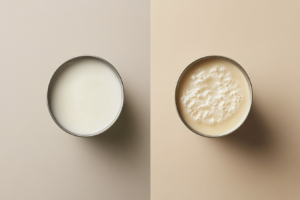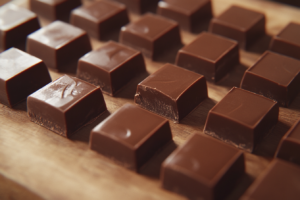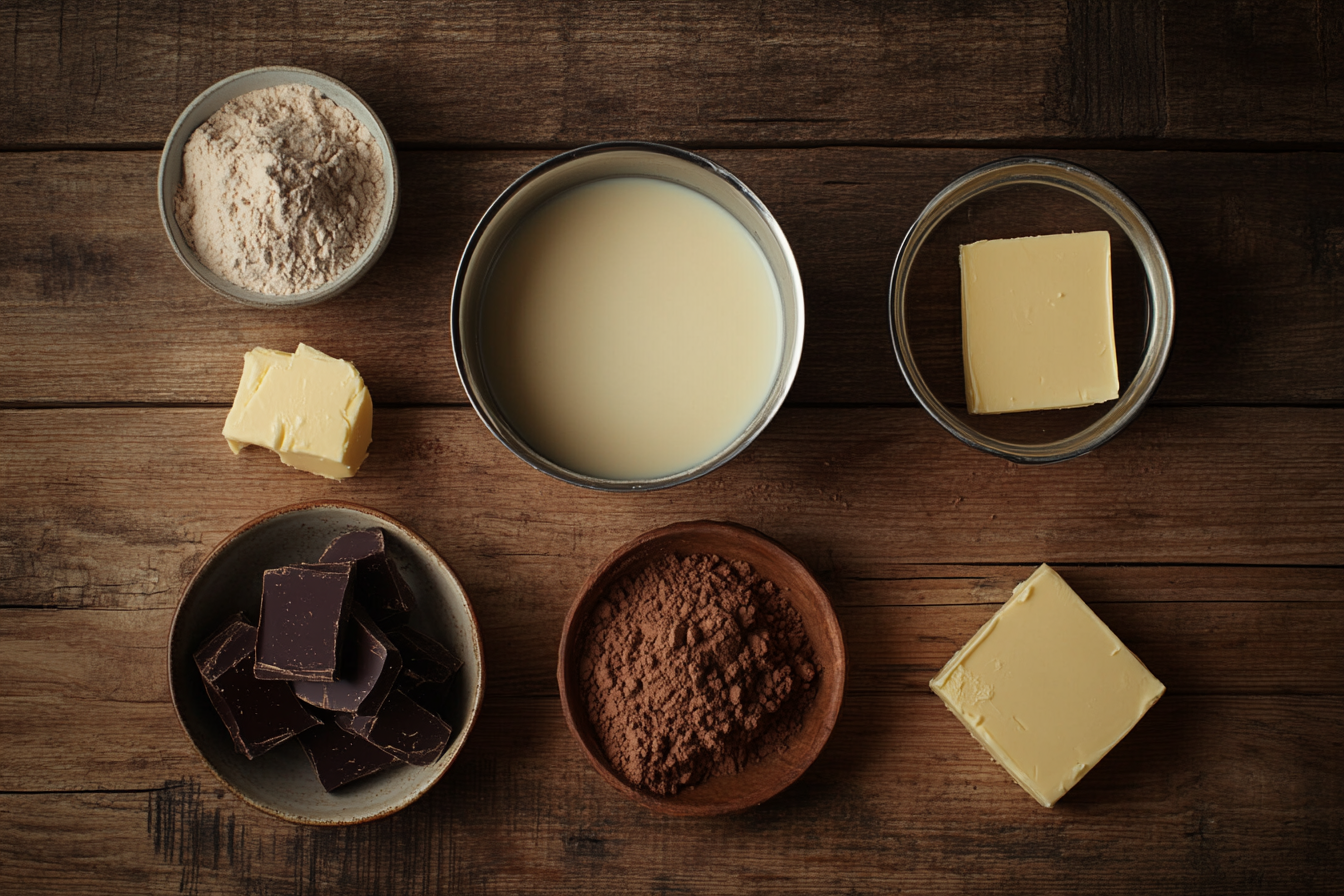When it comes to making fudge, one question pops up frequently: “Is evaporated milk or condensed milk better for fudge?” Both types of milk offer unique textures and flavors, but they aren’t interchangeable. So, which one creates that smooth, creamy fudge that melts in your mouth? In this article, we’ll explore the differences between evaporated and condensed milk, reveal the strengths of each for fudge-making, and provide insights into selecting the right milk for your perfect homemade fudge. Let’s dive into the details and discover which milk truly brings the best to your fudge!
Understanding Evaporated Milk and Condensed Milk
What is Evaporated Milk?
Evaporated milk is concentrated by heating regular milk until about 60% of its water evaporates. This process creates a thick, rich liquid with a mild taste. Evaporated milk works well in recipes that need a creamy texture without added sweetness, making it ideal for savory dishes and fudge when you want control over sugar levels.
The slight caramel color of evaporated milk adds a hint of flavor. Its unsweetened nature also lets you adjust the sweetness of your fudge recipe, allowing for more creativity with flavor profiles.
What is Condensed Milk?
Condensed milk is similar but includes added sugar. After removing about 60% of the water, producers mix in sugar, resulting in a thick, sweet liquid. This extra sugar doesn’t just add sweetness; it also creates a smoother, creamier texture, making fudge easier to prepare.
Using condensed milk simplifies fudge recipes because it combines milk and sugar into one ingredient. This sweetened milk’s golden color and rich flavor blend perfectly into desserts, which makes it a favorite for easy, reliable fudge.
Evaporated Milk vs. Condensed Milk

Although both start as regular milk, evaporated and condensed milk offer different qualities for fudge:
| Aspect | Evaporated Milk | Condensed Milk |
|---|---|---|
| Water Content | 60% removed | 60% removed |
| Sugar Content | Unsweetened | Sweetened |
| Color | Light caramel | Golden |
| Use in Fudge | Controls sweetness | Adds creaminess and sweetness easily |
In short, evaporated milk provides flexibility, while condensed milk offers built-in sweetness, making it perfect for rich, creamy fudge recipes.
Why Many Choose Evaporated Milk for Fudge
Benefits of Evaporated Milk in Fudge Recipes
Evaporated milk brings unique advantages to fudge. It helps create a creamy texture without adding extra sweetness, making it ideal for those who prefer rich, balanced flavors. Its subtle caramel notes also enhance the fudge’s taste without overpowering other ingredients, like chocolate or nuts.
Achieving the Ideal Texture with Evaporated Milk
When used in fudge, evaporated milk helps achieve a smooth, velvety consistency that holds its shape well. The concentrated milk solids in evaporated milk stabilize the mixture, preventing it from becoming too soft or sticky. This consistency is perfect for fudge that you can easily cut into firm squares.
Recipes Highlighting the Versatility of Evaporated Milk
Many classic fudge recipes call for evaporated milk due to its reliable consistency. Traditional chocolate fudge, peanut butter fudge, and other family favorites often use it as a core ingredient. With evaporated milk, these recipes achieve a delightful melt-in-your-mouth quality, allowing key flavors to shine.
In recipes where sweetness needs control, evaporated milk is often the preferred choice, offering flexibility for creating balanced and satisfying fudge.
Why Condensed Milk is Popular in Fudge
Advantages of Using Condensed Milk for Fudge
Condensed milk offers distinct benefits that make it a favorite for fudge lovers. Its sweetened nature simplifies recipes by eliminating the need to add extra sugar. The high sugar content not only adds sweetness but also creates a smooth, creamy texture without requiring complex techniques.
Since condensed milk combines milk and sugar in one ingredient, it’s particularly useful for beginners or anyone looking for a quick and reliable fudge recipe. Condensed milk’s sweetness and creamy consistency help achieve a deliciously rich fudge with minimal steps.
Perfect Texture and Flavor with Condensed Milk

Condensed milk brings a unique texture to fudge. Its thickness and sugar content give fudge a smooth, dense, and creamy consistency, which makes each bite rich and satisfying. The sugar in condensed milk also helps the fudge set more easily, reducing the chances of the mixture becoming grainy or overly soft.
Popular Recipes Featuring Condensed Milk
Many popular fudge recipes use condensed milk as a core ingredient. Quick fudge recipes, like three-ingredient chocolate fudge or microwave fudge, typically rely on condensed milk for simplicity and reliable results. These recipes are ideal for busy days or last-minute treats because condensed milk helps them come together quickly.
Condensed milk adds convenience to fudge-making while providing a decadent sweetness and creamy texture. Its simplicity and smoothness make it an ideal choice for easy, no-fail fudge recipes.
Choosing Between Evaporated and Condensed Milk for Fudge
Considering Taste Preferences
The type of milk you choose significantly affects the final flavor of your fudge. Condensed milk brings a rich, sweet flavor that appeals to those who love a sugary, dessert-like taste. Its sweetness works well in recipes where you want to indulge in a rich treat without adding extra sugar. On the other hand, evaporated milk provides a more subtle, balanced flavor, allowing other ingredients like chocolate or peanut butter to take center stage. If you prefer a less sweet fudge with more pronounced ingredient flavors, evaporated milk might be your best choice.
Impact on Texture and Consistency
Both types of milk contribute a creamy texture to fudge, but they affect consistency differently. Condensed milk produces a thick, dense texture that holds its shape well, ideal for soft, melt-in-your-mouth fudge. With evaporated milk, fudge often has a firmer texture, which is great if you prefer a slightly less sweet treat with a solid consistency. This difference can help guide your choice, depending on whether you want a softer or firmer fudge.
Health and Nutritional Factors
If you’re considering nutritional content, it’s worth noting the differences in sugar levels between these two types of milk. Condensed milk is high in sugar, making it significantly sweeter and calorie-dense. Evaporated milk contains no added sugar, which allows for better control over total sugar and calorie intake. Those looking to reduce sugar in their diet may prefer evaporated milk, as it lets you add just the amount of sugar you need.
In the end, choosing between evaporated and condensed milk depends on your taste, texture preferences, and health goals. Both offer delicious results but cater to slightly different fudge styles.
Step-by-Step Guide to Making Fudge with Evaporated Milk
Ingredients and Tools You’ll Need
For a classic fudge using evaporated milk, gather the following ingredients:
- 1 ½ cups granulated sugar
- 2/3 cup evaporated milk
- 2 tablespoons butter
- ¼ teaspoon salt
- 2 cups chocolate chips
- 1 teaspoon vanilla extract
You’ll also need a heavy saucepan, a wooden spoon for stirring, and an 8×8-inch pan lined with parchment paper.
Instructions for Making Fudge with Evaporated Milk
- Prepare the Pan
Line an 8×8-inch pan with parchment paper, letting the paper hang over the sides for easy removal later. - Combine Sugar, Evaporated Milk, Butter, and Salt
In a heavy saucepan, mix the sugar, evaporated milk, butter, and salt. Place the pan over medium heat. - Bring to a Boil
Stir the mixture continuously as it heats. When it starts boiling, reduce the heat slightly to maintain a gentle boil. - Boil for 4-5 Minutes
Continue stirring while the mixture boils for 4 to 5 minutes. Be cautious not to let it scorch; maintaining an even boil is key. - Remove from Heat and Add Chocolate and Vanilla
Turn off the heat and immediately stir in the chocolate chips and vanilla extract. Stir until the chocolate melts completely and the mixture is smooth. - Pour and Set
Pour the fudge mixture into the prepared pan, smoothing the top with a spatula. Let it cool at room temperature for 1 to 2 hours, or until firm. - Cut and Serve
Once set, lift the fudge out of the pan using the parchment paper edges. Cut it into squares and enjoy!
This fudge recipe with evaporated milk creates a firm, rich texture that’s smooth yet not overly sweet.
Step-by-Step Guide to Making Fudge with Condensed Milk
Ingredients and Tools Needed
To make creamy fudge with condensed milk, gather the following ingredients:
- 1 can (14 ounces) sweetened condensed milk
- 2 cups chocolate chips (milk, dark, or semi-sweet, depending on your preference)
- 1 teaspoon vanilla extract
- Optional toppings: chopped nuts, sea salt, or sprinkles
You’ll also need a medium saucepan, a heatproof mixing bowl, a spatula, and an 8×8-inch pan lined with parchment paper.
Instructions for Making Fudge with Condensed Milk

- Prepare the Pan
Line an 8×8-inch pan with parchment paper, ensuring the paper extends beyond the edges for easy removal. - Melt the Chocolate and Condensed Milk Together
In a medium saucepan, combine the chocolate chips and sweetened condensed milk. Set the heat to low and stir continuously to prevent burning. - Stir Until Smooth and Combined
As the chocolate melts, keep stirring until the mixture becomes smooth and fully combined. Avoid overheating, as this can affect the texture of the fudge. - Add Vanilla Extract
Remove the saucepan from the heat and stir in the vanilla extract, blending it well. - Pour the Mixture into the Pan
Pour the fudge mixture into the prepared pan, spreading it evenly with a spatula. Add any optional toppings at this stage, such as chopped nuts or a sprinkle of sea salt, for added flavor and texture. - Let the Fudge Set
Allow the fudge to cool at room temperature or refrigerate it for 1-2 hours until firm. Condensed milk fudge generally sets quickly and holds its shape well. - Cut into Squares and Serve
Once set, lift the fudge out of the pan using the parchment paper and cut it into squares. Serve and enjoy the creamy, sweet treat!
Using condensed milk simplifies fudge-making, giving you a smooth and rich texture without needing additional sugar.
Expert Tips for Perfect Fudge
Control the Temperature for Best Results
Achieving the perfect fudge texture often comes down to temperature. Use a candy thermometer if possible to monitor the heat when cooking your ingredients. For evaporated milk fudge, aim to maintain a gentle boil without allowing it to scorch. For condensed milk fudge, keep the heat low and stir frequently. Overheating condensed milk can lead to a grainy texture, which affects the final product’s smoothness.
Stirring Techniques for Smooth Fudge
Consistent stirring plays a crucial role in fudge-making. Stir continuously while the mixture heats, especially when using evaporated milk. This helps prevent sticking and ensures even cooking. Once the mixture reaches the right consistency, stop stirring to let the fudge set properly. Over-stirring after the mixture cools can cause it to become grainy or lose its smooth texture.
Allow the Fudge to Set Properly
After pouring the fudge into the pan, give it ample time to set. Avoid rushing this process by refrigerating too soon, as it can lead to uneven texture. Room temperature setting usually yields the best results, especially with evaporated milk fudge, which may need a bit more time to firm up. Patience here will reward you with fudge that’s easy to cut and holds its shape beautifully.
Experiment with Flavor and Texture Additions
Fudge is versatile, allowing for endless creative touches. Add-ins like nuts, marshmallows, or sea salt can enhance flavor and texture. For condensed milk fudge, these additions integrate seamlessly, thanks to its smooth, creamy consistency. With evaporated milk fudge, mix-ins can be added after the chocolate and vanilla, just before pouring into the pan.
By mastering these techniques, you’ll be well on your way to creating consistently delicious fudge every time, whether you choose evaporated or condensed milk.
Comparing Fudge with Evaporated Milk vs. Condensed Milk
Texture Comparison: Soft vs. Firm
When it comes to texture, the choice between evaporated and condensed milk makes a noticeable difference. Fudge made with condensed milk generally has a softer, denser texture with a melt-in-your-mouth feel. Condensed milk’s added sugar contributes to a rich creaminess, making it easy to slice and ideal for smooth, indulgent bites.
On the other hand, evaporated milk produces a slightly firmer fudge. Because it’s unsweetened, you have more control over the consistency, allowing for adjustments based on personal preference. This type of fudge tends to hold its shape well and is perfect for those who enjoy a solid, biteable texture.
Flavor Comparison: Sweetness Levels
The choice between evaporated and condensed milk also impacts the sweetness of your fudge. Condensed milk adds a pronounced sweetness, which is convenient for fudge recipes since it reduces the need for additional sugar. This sweetness pairs well with chocolate or any bold, dessert-friendly flavors.
Evaporated milk, on the other hand, offers a more balanced flavor with less inherent sweetness. This allows other ingredients, like cocoa or peanut butter, to shine without an overwhelming sugary taste. If you prefer a milder sweetness, evaporated milk might be the way to go, as it provides a foundation for customized sweetness levels.
Ease of Preparation
For simplicity, condensed milk is the top choice for many fudge recipes. Since it combines milk and sugar, it eliminates the need for separate measurements and additional ingredients. Beginners and those in a rush often prefer condensed milk fudge due to its minimal steps and reliable results.
Evaporated milk fudge, however, requires a bit more attention to achieve the right consistency, especially in managing sugar levels. It’s ideal for those who want to experiment with varying sweetness and flavor, providing flexibility for personal adjustments.
Choosing between evaporated and condensed milk ultimately depends on whether you prioritize ease, sweetness, or control over texture. Both options yield delicious results, each offering unique qualities that make fudge-making a delightful experience.
Choosing the Best Type of Milk for Your Fudge
Summary of Recommendations Based on Preferences
When deciding between evaporated and condensed milk for fudge, consider your specific preferences and needs. Here’s a quick guide to help you choose:
- For a Rich, Sweet Flavor: Choose condensed milk. Its natural sweetness enhances chocolate and other dessert flavors without needing extra sugar. This choice is perfect for those who enjoy traditional, candy-sweet fudge.
- For a Balanced, Less Sweet Flavor: Opt for evaporated milk. Its unsweetened nature provides a clean slate, letting you control the sweetness level while still delivering a creamy, firm fudge.
- For Easy, Quick Fudge Recipes: Condensed milk offers simplicity, combining milk and sugar in one ingredient, which speeds up preparation and ensures smooth, creamy results.
- For More Texture Control and Customization: Evaporated milk allows flexibility in adjusting sugar levels and flavor, ideal for those who want to experiment or prefer a firmer fudge texture.
Making the Final Choice
Whether you lean toward condensed milk for ease and sweetness or evaporated milk for control and versatility, both options offer delicious outcomes. Each milk type contributes uniquely to the fudge’s texture, taste, and ease of preparation. Consider your taste preferences, dietary needs, and recipe goals when choosing the best milk for your fudge-making adventure.
This guide aims to equip you with the knowledge to create the perfect fudge, customized to your liking. Now, you’re ready to dive into fudge-making, knowing exactly what each type of milk brings to the table. Enjoy crafting your ideal fudge, and don’t be afraid to experiment with both kinds of milk to find your favorite!
Frequently Asked Questions (FAQs)
1. Can I Substitute Evaporated Milk for Condensed Milk in Fudge?
In most cases, evaporated milk and condensed milk are not interchangeable in fudge recipes. Condensed milk is sweetened, while evaporated milk is not. If you substitute evaporated milk in place of condensed milk, you’ll need to add sugar to achieve a similar level of sweetness and consistency. However, the texture and flavor may still vary slightly.
2. What Is the Main Difference Between Evaporated and Condensed Milk?
The main difference lies in the sugar content. Condensed milk is sweetened, making it thicker and ideal for desserts. Evaporated milk, on the other hand, is unsweetened, giving it more versatility in both sweet and savory dishes. This difference in sweetness and thickness plays a major role in the texture and flavor of fudge.
3. Which Milk Type Is Better for a Healthier Fudge?
If you’re looking to reduce sugar content, evaporated milk is typically a better choice. Since it has no added sugar, it allows you to control the amount of sweetness in the recipe. Condensed milk, while convenient, contains a significant amount of sugar, making fudge richer in calories and sugar.
4. Are There Dairy-Free Alternatives for Evaporated or Condensed Milk in Fudge?
Yes, you can use coconut milk, almond milk, or other plant-based milks as dairy-free substitutes. Coconut milk, in particular, has a similar consistency to evaporated milk. For a dairy-free version of condensed milk, some recipes suggest simmering coconut milk with a sweetener like maple syrup until it thickens.
5. Does Fudge Made with Condensed Milk Last Longer?
Fudge made with condensed milk often has a longer shelf life due to its high sugar content, which acts as a preservative. If stored properly in an airtight container, it can last up to two weeks at room temperature or even longer when refrigerated. Fudge made with evaporated milk may need refrigeration sooner to maintain freshness.
This FAQ section addresses some of the most common questions about using evaporated and condensed milk in fudge recipes, providing additional insights to help you make informed choices in the kitchen. Enjoy experimenting and finding the perfect method for your fudge-making adventures!

